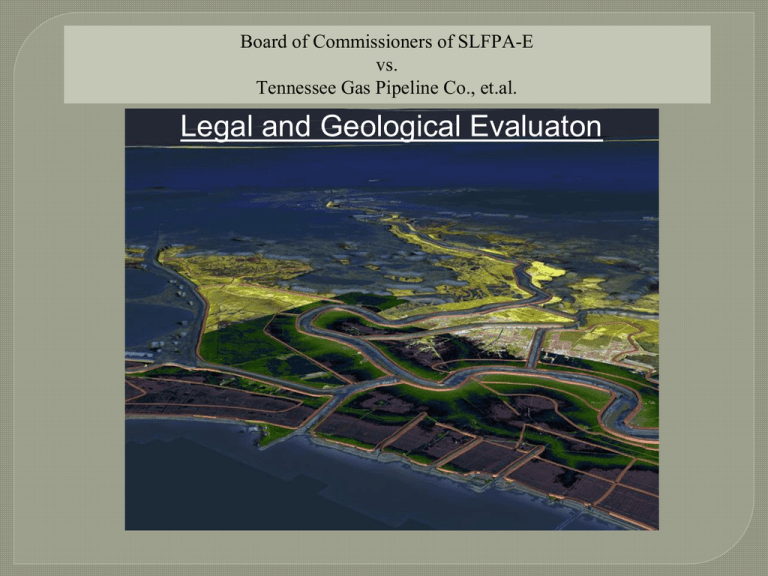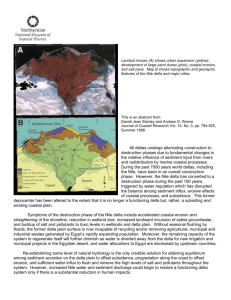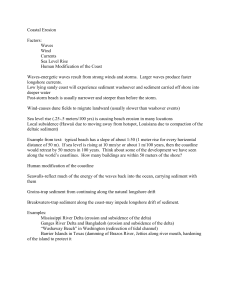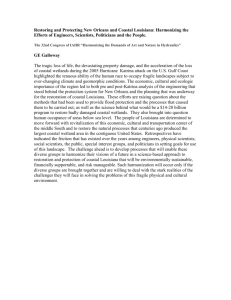.Chris McLindon and Edward Richards - Board of Commissioners of SLFPA-E vs. Tennessee Gas Pipeline Co., et.al. - Legal and Geological Evaluation
advertisement

Board of Commissioners of SLFPA-E vs. Tennessee Gas Pipeline Co., et.al. Legal and Geological Evaluaton Bd. of Comm'rs of the S.E. La. Flood Prot. Auth. E. v. Tn. Gas Pipeline Co., LLC., et al., No. 13-6911 (D. Ct. Orleans Parish, La. Jul 24, 2013). The Coastal “Erosion” Lawsuit The Parties ⦿ Plaintiffs • Southeast Louisiana Flood Protection Authority - East ("the Authority"), individually and as the board governing the Orleans Levee District, the Lake Borgne Basin Levee District, and the East Jefferson Levee District ⦿ Defendants • List of energy companies involved in exploration and production over the past 80 years. The Good Old Days “Coastal lands have for centuries provided a crucial buffer zone between south Louisiana's communities and the violent wave action and storm surge that tropical storms and hurricanes transmit from the Gulf of Mexico. Coastal lands are a natural protective buffer, without which the levees that protect the cities and towns of south Louisiana are left exposed to unabated destructive forces.” The Delta after 1932 “This natural protective buffer took 6,000 years to form. Yet, as described below, it has been brought to the brink of destruction over the course of a single human lifetime. Hundreds of thousands of acres of the coastal lands that once protected south Louisiana are now gone as a result of oil and gas industry activities...” The Legal Claims ⦿ This is a third party beneficiary lawsuit. • The landowners have the primary rights to the restoration of the land after production. • The damage to the land increased the cost of hurricane protection to the levee board. ⦿ The mechanism of damage • Canals and pipelines destroyed wetlands, which acted as buffers against hurricane storm tide. • Oil extraction caused surface subsidence, which increases the risk of hurricane storm tide. The Coastal Restoration Demand “...including, but not limited to, backfilling and revegetating each and every canal dredged by them, used by them, and/or for which they bear responsibility, as well as undertaking all manner of abatement and restoration activities determined to be appropriate, including, but not limited to, wetlands creation, reef creation, land bridge construction, hydrologic restoration, shoreline protection, structural protection, bank stabilization, and ridge restoration...” Wetlands Lost Since 1932 Port Fourchon 193 2 GILL, 2013 201 0 GILL, 2013 U.S.G.S - Land Area Change in Louisiana 1932-2010 Coastal Land Area Change since 1932 2 Average rate = ~20 mi /yr 1880 sq. mi decrease in wetlands coverage in 78 years USGS, ALEXANDER, et.al., 2012 Why 1932? ⦿ The plaintiffs and their supporters would say that oil exploration began in earnest in the 1930s. ⦿ While that is true, the reason that the coastal wetlands loss begin with 1932 is that was the year when aerial photography of the coast began. ⦿ The missing information is what happened before 1932. Determining the Effect of Oil and Gas Production post 1932 This requires determining what other human factors have affected the delta since 1932 and the effect of longer term natural processes. Why 1932 Might Be the Modern Sediment High Point 19 32 TWEEL & TURNER, 2012 Anthropogenic Changes Since 1932 ⦿ Sediment in the river peaked in 1932, then declined due to modern farming practices and levees. ⦿ Dams have been built, trapping sediment. ⦿ Levees have been built, preventing upstream sediment from entering the river and downstream sediment from flooding the delta. Long Term Natural Processes The Mississippi Delta from the Holocene to 1932 Why do Plaintiff’s Claim the Wetlands Built over 6000 Years? ⦿ This in the end of the Holocene, which began about 12,000 years ago. ⦿ The glaciers were melting and sea level was rising until about 6,000 years ago. ⦿ The modern Mississippi Delta started 6,000 years ago. What was here before the Modern Delta? ⦿ The ice cap from the last ice age was at the maximum about 20-25,000 years ago. ⦿ So much water was tied up in the ice that the sea level was about 120 meters (nearly 400 feet) lower than today. ⦿ The Mississippi River was more than 100 miles out into the Gulf of Mexico, in a huge canyon. ⦿ What is seen as the delta did not exist. Exposed Continental Shelf During the last Ice Age Higher Uplands Pleistocene Terrace Pleistocene erosional surface Exposed Shelf BLUM & ROBERTS, 2011 FISK, 1944 What Happened When the Ice Melted? ⦿ The Mississippi was a flooding torrent for thousands of years and carried much more sediment at that time than since. ⦿ Despite this mountain of sediment, coastal edge – what we call the delta today – retreated inland more than 100 miles. ⦿ Lesson for sea level rise from climate change: sea level rise trumps sediment. Rising Sea Level as Ice Cap Melted Higher Uplands Braided stream aggradation Pleistocene Terrace Holocene delta deposits BLUM & ROBERTS, 2011 FISK, 1944 Building the Modern Delta All of the modern river deltas started to build when sea level stabilized about 6,000 years ago. As long as sea level was rising at a significant rate, the coast line retreats inland because the river cannot build a delta uphill. Post-Glacial Maximum Sea Level ⦿ Donoghue, Joseph F. “Sea Level History of the Northern Gulf of Mexico Coast and Sea Level Rise Scenarios for the near Future.” Climatic Change 107, no. 1–2 (2011): 17–33. Recent Deltatic Deposits of the Mississippi River: Their development and chronology – David E. Frazier, 1967 Thousand Years Before Present 6 5 4 3 2 1 0 The Delta Cycle Chandeleur Islands Grand Isle Ship Shoal Mississippi River Delta 5,500 years before present Pine Islands 0 2 Trinity Islands 0 1 3 2 4,500 years before present 0 2 1 Trinity Shoals 0 1 3 2 2 + 2095 mi mi 2 892 3,500 years before present 0 0 3 Trinity Shoals 0 1 3 2 0 2 + 4315 mi mi 2 886 2,500 years before present 0 1 2 Trinity Shoals 0 1 1 Outer Islands 3 2 2 + 3306 mi mi 2 2411 2,500 years before present Bayou Jasmine Archeological Site Twinned bag ca. 800 BC 0 LSU TEXTILE MUSEUM 1 2 Trinity Shoals 1 Outer Islands 2 + 3306 mi mi 2 2411 1,500 years before present 2 1 0 3 St Bernard Islands Trinity Shoals 0 1 1 Ship Islands Outer Shoal 3 2 0 2 + 3657 mi mi 2 2349 500 years before present Chandeleur Islands 2 0 3 St. Bernard Shoal 0 Trinity Shoals 0 1 2 Ship Shoal Outer Shoal 3 2 2 + 2075 mi mi 2 2504 82 years before present (1932) Chandeleur Islands 2 3 0-1 0 Trinity Shoals Isle Dernier 0 1 1 Ship Shoal Outer Shoal 3 2 St. Bernard Shoal Grand Isle 2 + 1342 mi mi 2 1082 Land Lost before 1932 ~10,000 mi 2 Total estimated submergence prior to 1932 This land was lost without human intervention Subsidence and the Delta Cycle 33’/2100 yrs = 0.2 in/yr = 5 mm/yr Subsidence Today ⦿ The historic sediment load on the delta causes the subsidence that creates the space for the river to deposit the new sediment – the accommodation space. ⦿ As we have seen, when the river is not putting sediment in an abandoned part of the delta, the subsidence continues and the abandoned lobe sinks below the water. ⦿ This subsidence is drowning the coast. stable Subsidence and the Sediment Load Shinkle and Dokka (2004) NOAA Tech. Rept. 50 Stars 0 inch/yr uplift Blue square -1/3 inch/yr Green square -1/2 inch/yr Yellow circle -3/4 inch/yr Coastal parishes avg. = ~-1/2 inch/yr 1960s-1980s Load of Holocene Mississippi River Delta © 2003 Louisiana State University Predicted present-day vertical motions in mm/yr from delta & ocean loads Ivins et al (2006) GULFNet station at Cocodrie, LA →sinking 6.3 mm/yr Development of the Coastal Erosion Model The Standard Accepted Model for Land Loss on which the Lawsuit is Based is fundamentally flawed Two Foundational Studies “Total canal area is estimated to be 10% of the Louisiana coastal region in 1978 and directly accounts for approximately 6.3% of the total wetlands loss from circa 1955 to 1978. However a strong statistical relationship exists between canal density and total wetlands loss indicates that the indirect impacts of canals account for a substantially larger percentage of total wetlands loss.” Page 56 Process Classification of Coastal Land Loss 1932 – 1990 Penland, et. al., 1990 Penland’s Coastal Land Loss 1932 – 1990 Energy Industry Operations in the Wetlands CHAVIN MONTEGUT CHAVIN LIRETTE Lake Boudreaux DULAC BAYOU RAMBIO LAPEYROUSE A Middle Miocene Fields CHAVIN B B A’ BAYOU RAMBIO A A’ B’ LAPEYROUSE LIRETTE B’ Surface Fault Traces Surface Fault Traces Subsidence Due to Faulting Marsh Subsidence Due to Faulting Land Loss Due to Faulting Causal and Non-causal correlations Regional Geology Holocene N Pliocene & Pleistocene Pre-Miocene Tertiary Empire Fault West Delta Fault The Terrebonne Trough S Land Loss in Southeast Louisiana Faults and Land Loss Measuring Subsidence subsidence Effects of Subsidence and Sea Level Rise 193 2 470 mm = 18.5” total relative sea level rise since 1932 subsidence sea level rise 201 0 1932 Subsidence in mm/yr Dokka, R et.al., 2009, Gulf Coast subsidence, crustal loading, geodesy, and InSAR: Gulf Coast Association of Geological Societies Transactions, v. 59, p. 101-114. 5 mm/yr 6 mm/yr Fort Proctor Subsidence in mm/yr Dokka, R et.al., 2009, Gulf Coast subsidence, crustal loading, geodesy, and InSAR: Gulf Coast Association of Geological Societies Transactions, v. 59, p. 101-114. Board of Commissioners of SLFPA-E vs. Tennessee Gas Pipeline Co., et.al. Assertions • 6,000 Year Steady State Hypothesis • 1930’s Represent A Baseline Of Normality • Oilfield Canals Destroyed Wetlands • Oil Extraction Causes Subsidence • Coastal Wetlands Protect Against Storm Surge • Coastal Restoration Is Possible “Reconnecting the River to the Marsh” LACES, KHALIL, 2012 West Bay Sediment Diversion West Bay Sediment Diversion “… it would appear unlikely that large areas of new land would develop in West Bay over a time scale of less than a few decades.” Kolker, et.al., 2012 LACES, KHALIL, 2012 USGS Land Area Change 1932 2010 Caenarvon Freshwater Diversion “The evidence indicates that diversions not only fail to conserve mature brackish and tidal freshwater marshes, but disrupt plant physiology in ways that endanger individual plant vigor and overall marsh survival.” Kearney, et.al., 2011 Relative Sea Level Rise The Interplay of Subsidence and Sea Level Rise IPCC Sea Level Projections The Impact of Sea Level Rise ⦿ Without sea level rise, it would be technically, if not politically, possible to increase sediment and slow the delta loss. • This would require removing the levees and dams. ⦿ With increasing sea level rise, the coast line will rapidly retreat inland, no matter what is done. 2100 – Minimum Sea Level Rise + Subsidence (subsidence + sea level rise = 1 meter) Do Wetlands Reduce Flooding? ⦿ Mangroves and tsunamis • Tall, dense • Fast pulse, then gone ⦿ Fresh and Salt Marsh • Not tall. • Hurricanes have time to flow through the wetlands and equilibrate. • Wave attenuation falls off once the plants are submerged. ⦿ Forerunner Surge – Next Slide Forerunner Surge on Bolivar from Ike ⦿ This submerges the marshes before the storm. Wetlands do not Reduce Flooding in Louisiana ⦿ Coastal wetlands have other values, and canals may have done real damage to salt marsh. ⦿ But wetlands do not reduce hurricane surge on the Louisiana coast. ⦿ Thus, for the purposes of this lawsuit, it does not matter whether canals destroyed the wetlands. ⦿ It also means that even if the wetlands could be restored, it would not change flood risk. What Can The Energy Industry do to be a Better Coastal Citizen? Back Good Science! ⦿ Stop supporting groups like America’s Wetlands and CPRA that deny the effects of subsidence and climate change (sea level rise). ⦿ Create a public forum for discussions of accurate coastal science, especially geology and climate change. ⦿ Fund research on key points such as the effect of oil production on subsidence. Admit Your Own Vulnerabilities “We conservatively estimate that a three-week loss in services from Port Fourchon would lead to: • A loss of $9,994.7 mm in sales at US firms • A loss of $2,890.9 mm in household earning • A loss of 77,400 jobs in the nation” Take Climate Change, Sea Level Rise, and Geology Seriously ⦿ Start moving critical infrastructure inland out of high risk areas such as Port Fourchon, Houma, and New Orleans. ⦿ Encourage employees and suppliers to relocate inland. ⦿ This will support retreat and will increase resilience. ⦿ It will save money and disruptions in the long term Get the Rhetoric Right! ⦿ False concepts • Erosion, restoration, crumbling into the Gulf, losing the land of our heritage, and reconnecting the river to the marsh. ⦿ Correct concepts • The delta cycle, global warming, sea level rise, retreat, subsidence, living in harmony with nature. ⦿ The levee board and Parish lawsuits are just the beginning. • As long as people believe in restoration, they will expect the oil industry to pay for it. The End




